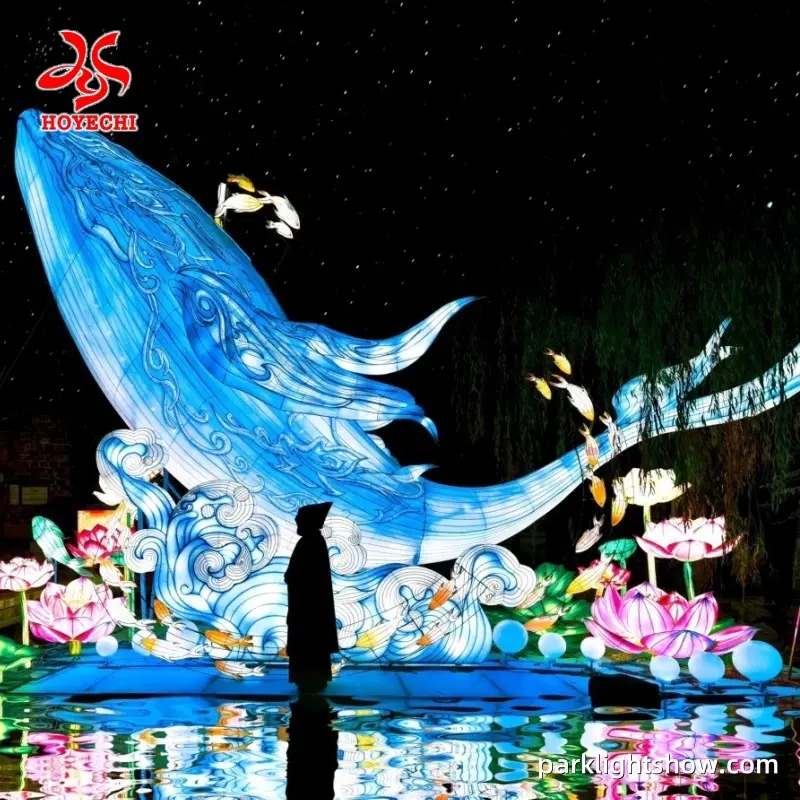How Modern Whale Lanterns Are Made: A Look Into Lantern Craft
Large decorative lanterns are the centerpiece of many modern light festivals. The whale-shaped lantern in the image represents a new generation of lantern art that combines traditional craftsmanship with contemporary engineering. Although it looks like an illuminated sculpture, every section follows precise lantern-making techniques. Below is a clear look into how such a large lantern is built.
1. Metal Framework: The Structural Foundation
Every large lantern begins with a structural metal frame. For a whale design, craftsmen bend and weld steel tubes, iron rods, and reinforced joints to form the full three-dimensional outline. Because of the lantern’s size, internal beams and cross-bracings are added to prevent deformation, especially for long curved sections like the whale’s body and tail. The frame must withstand outdoor weather, so stability calculations are performed before production.
2. Fabric Covering and Hand-Painting
Once the frame is complete, artisans cover the structure with translucent materials such as silk cloth, PVC light film, or mesh fabric. These materials are secured tightly around the curves to avoid wrinkles or dark spots when illuminated.
The whale’s blue gradients, flowing lines, and wave patterns are created through manual painting rather than printing. Painters apply base colors first, then outline details and blend layers to achieve the waterlike transparency. When lit, the hand-painted textures give the lantern its depth and realism.
3. LED Lighting System: Bringing the Lantern to Life
Modern lanterns rely on LED lighting as their core illumination system. Inside the whale, LED strips, RGB color-changing bulbs, and diffusion sheets are installed to create soft, uniform lighting. A programmed controller manages brightness and color transitions, allowing the lantern to simulate swimming motions through sequential lighting from head to tail. This dynamic lighting is what sets contemporary lanterns apart from traditional static ones.
4. Themed Surrounding Elements
The lotus flowers, koi fish, and wave elements around the whale form a themed “scenic group.” These smaller lanterns follow the same craftsmanship but serve to enrich the atmosphere and create a complete viewing scene. The layered arrangement ensures that visitors experience the artwork from multiple angles, a key principle in modern lantern show design.
Combination of traditional lanterns and modern technology
The whale lantern showcases the evolution of Chinese lantern craftsmanship. Through metal framework engineering, hand-painted fabric techniques, and LED lighting control, traditional lantern art has transformed into immersive large-scale light installations. Such lanterns not only continue cultural traditions but also enhance night-tourism experiences in cities worldwide.
1. What materials are used to make large lanterns?
Large lanterns typically use steel or iron frames, translucent PVC or silk fabrics, hand-painted surfaces, and LED lighting components.
2. How long does it take to build a lantern of this size?
A medium to large lantern usually requires 1–3 weeks depending on complexity, painting detail, and lighting programming.
3. Are these lanterns weather-resistant?
Yes. Professional lanterns are designed to withstand outdoor environments, with reinforced frames and moisture-resistant fabrics.
4. What kind of lighting systems are used?
Modern lanterns use LED strips, RGB bulbs, and DMX or programmed controllers to create dynamic lighting effects.
5. Can whale lanterns or other designs be customized?
Absolutely. Lantern companies can design any theme—animals, plants, architecture, or cultural motifs—based on customer requirements.
6. Are lanterns considered traditional Chinese art?
Yes. Lantern making is a traditional craft that originated over a thousand years ago. Modern lantern shows integrate technology but still follow traditional methods.
Post time: Nov-18-2025





